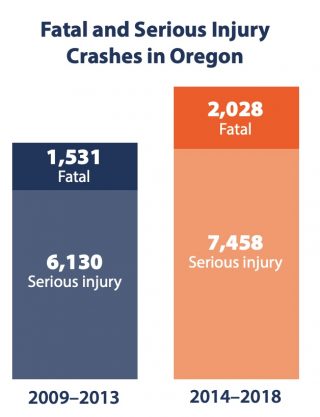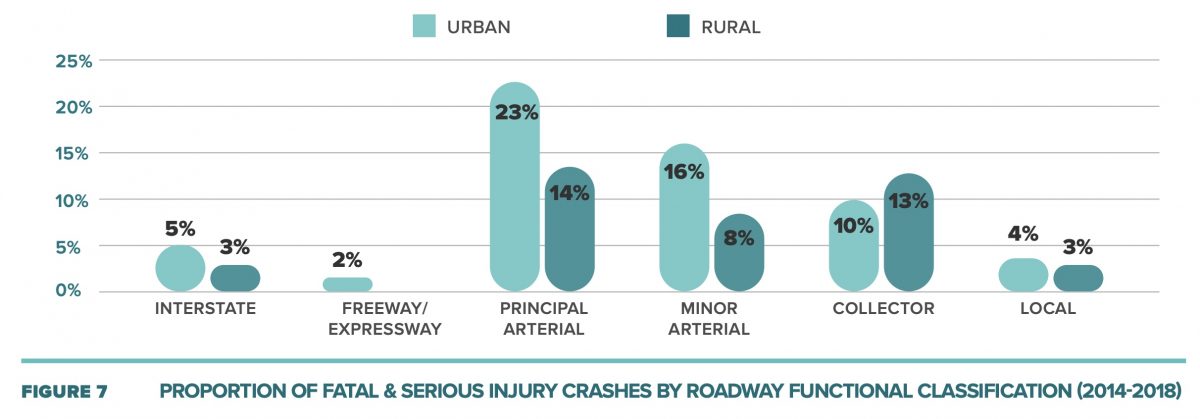
(Photo: Jonathan Maus/BikePortland)
The 502 people who died while using Oregon roads in 2018 was a 15-year high. So far this year, fatal traffic crashes are up over 24% from 2020 levels. Oregon has a lot of work to do if we want to reach our goal of zero deaths or life-changing injuries by 2035.
The roadmap to get us there is the Transportation Safety Action Plan (TSAP), a document required by federal law and created by the Oregon Department of Transportation. A draft version of the latest TSAP is out now and public comments are being accepted until July 9th.
The TSAP is an important tool for advocates and policymakers for many reasons. For one, money flows directly from its findings and recommendations toward programs, city grant disbursements, and so on. The plan can also be a powerful way to hold ODOT accountable for how they manage the transportation system. According to ODOT, this TSAP update,
“… will analyze what has changed since the adoption of the 2016 plan, evaluate the progress towards achieving the elimination of fatalities and serious injuries on Oregon’s transportation system, and identify solutions to address system needs for all travelers.”
Advertisement

[Our coverage of last TSAP update in 2016: Oregon just adopted a new transportation safety plan: Here’s what’s in it]
In addition to the personal trauma and tragedy of traffic crashes, ODOT’s draft plan puts the average annual economic cost of crashes in Oregon over the most recent five-year planning period (2014-2018) at $5.81 billion — more than twice their annual budget.
One way Oregon could save many lives is to focus on arterial roads. Between 2014 and 2018, 61% of all fatal and serious injury crashes occurred on an arterial. The biggest culprit according to official data are “roadway departure” crashes where a person fails to control their vehicle and they leave the road, often smashing into a fixed object. Those type of crashes made up 41% of all fatal and serious injuries in the five-year period. Intersection crashes were second at 36%.
Advertisement

Data is crucial and it’s one area ODOT needs feedback on. “Crash data provides an important starting point toward deciding the distribution of limited resources,” reads the plan. Regulations that would compel first responders and/or law enforcement officials to more thoroughly investigate whether or not a vehicle operator was distracted by a device is one way we might reap safer outcomes.
One proven way to save lives is to reduce exposure to driving cars and trucks — which account for nearly 100% of all deaths and injuries on our roads. ODOT is infamous for being a driving-centric agency and they often make decisions that encourage driving and make it easier and more dangerous at the expense of other modes. If ODOT is serious about reaching a statewide zero fatality and injury goal in 15 years, they must begin to build a system that is much less reliant on the most deadly vehicles. Nothing in this plan alludes to a more low-car future for Oregon.
When it comes to modes, bicycling accounts for the fewest number of fatal and serious injury crashes in Oregon. From 2014-2018, 3.5% of them were to bicycle riders. (Read more about ODOT’s approach to bicycling safety on page 95 of the plan.)
Instead of continuing to invest in traditional safety measures that accept driving hegemony as a given, ODOT could forge a new path and inspire other road agencies (the plan applies to all roads, even ones owned by cities and counties).
Now might be an good time for a consequential TSAP update because long-time leader of ODOT’s Traffic Safety Division, Troy Costales (who I interviewed in 2010), is set to retire on July 1st. In light of that change in leadership, ODOT recently changed the name of that division to the Transportation Safety Office and has housed it in the Department of Motor Vehicles under DMV Administrator Amy Joyce.
“These moves will embed safety experts into areas of the agency responsible for communicating about safety and setting policy,” read an ODOT statement about the organizational shift. “For instance, the Highway Safety Section and DMV already work to provide critical safety information to employees and Oregonians through a variety of programs including driver education, motorcycle safety training, third-party drive testing, driver safety and crash reporting.”
ODOT Assistant Director Travis Brouwer told BikePortland via Twitter in May that the move will come with, “A lot of benefits” and that Joyce, “Has a passion for safety.”
Help all of ODOT have a greater passion to save lives by sharing a comment about the TSAP. See the draft plan here and submit your comments to them via safety@odot.state.or.us by July 9th.
— Jonathan Maus: (503) 706-8804, @jonathan_maus on Twitter and jonathan@bikeportland.org
— Get our headlines delivered to your inbox.
— Support this independent community media outlet with a one-time contribution or monthly subscription.


